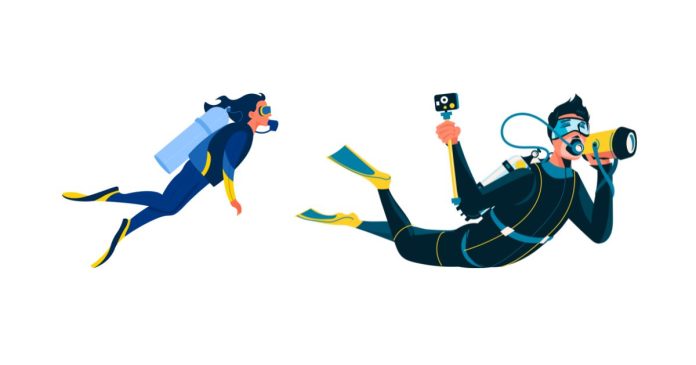Have you ever wondered what the difference is between diving and scuba diving? Both activities involve exploring underwater, but they vary significantly in terms of techniques, equipment, and depth. While the terms are sometimes used interchangeably, they actually refer to two distinct types of water exploration. In this blog post, we’ll break down the key differences between diving and scuba diving, so you can better understand each and determine which one is right for you.
What is Diving?
Diving, in the simplest terms, refers to the act of jumping or falling into water from a high point, such as a diving board, cliff, or platform. In this context, “diving” typically refers to the physical activity of entering the water in a controlled way, often as a sport or recreational activity. Diving can be done in pools, lakes, or oceans, and may involve varying degrees of depth.
There are different forms of diving, including:
- Platform or Springboard Diving: This is the kind of diving seen in the Olympics, where athletes perform acrobatic maneuvers from a diving board or platform before entering the water.
- Free Diving: This type of diving involves diving underwater without any breathing apparatus. Free divers rely on holding their breath while exploring underwater for short periods. This activity can be done without equipment or with minimal tools like fins and masks.
What is Scuba Diving?
Scuba diving is a specialized form of diving that involves using a self-contained underwater breathing apparatus (SCUBA) to allow divers to explore underwater for extended periods. The key difference between diving and scuba diving is that in scuba diving, divers can breathe underwater through tanks filled with compressed air or other gases.
Scuba diving opens up a whole new world of underwater exploration, as divers can go deeper and stay longer than in regular diving. The use of equipment such as a mask, fins, wetsuit, regulator, and tank allows for greater mobility and comfort under the water, making it suitable for activities like marine exploration, shipwreck exploration, and underwater photography.
Key Differences Between Diving and Scuba Diving
Now that we’ve defined each activity, let’s compare them in more detail to understand the main distinctions:
Equipment
- Diving: Typically involves minimal equipment, like a mask, fins, and occasionally a snorkel for surface swimming. If you’re free diving, you might only need fins, a mask, and a wetsuit.
- Scuba Diving: Requires more extensive gear, including a scuba tank filled with air, a regulator to breathe from the tank, a buoyancy control device (BCD) to help maintain neutral buoyancy underwater, and often a wetsuit or drysuit for warmth.
Breathing
- Diving: In traditional diving or free diving, you rely on holding your breath while submerged. The depth and duration are limited by your ability to hold your breath.
- Scuba Diving: Scuba divers are able to breathe continuously through their regulator while underwater, as long as they have air in their tank. This allows for longer dives at greater depths.
Depth and Duration
- Diving: Free diving typically limits how deep you can go (usually no more than 100 feet) and how long you can stay underwater, as it depends on your ability to hold your breath. Platform or springboard diving is done from shallow depths.
- Scuba Diving: Scuba divers can go much deeper, typically between 30 to 130 feet for recreational divers, and can stay submerged for much longer periods, depending on the dive and the air supply.
Training and Certification
- Diving: While free diving requires some basic training to dive safely, it doesn’t usually require certification. However, free divers must still be aware of breath-hold diving safety to prevent issues like shallow water blackout.
- Scuba Diving: Scuba diving requires formal training and certification to ensure safety. To become a certified scuba diver, you need to take a course from a recognized agency (like PADI or NAUI), which includes theory lessons, practical training, and open-water dives.
Safety Considerations
Both diving and scuba diving come with inherent risks, but scuba diving requires additional precautions due to the use of compressed air and the potential for deeper dives. Here are some key safety tips for both activities:
- Diving: When free diving, it’s important to never dive alone and to always have a buddy to help in case of emergency. Pay attention to your body’s limits, as holding your breath for too long or diving too deep can be dangerous.
- Scuba Diving: Scuba divers need to be aware of decompression sickness, also known as “the bends,” which occurs when a diver ascends too quickly after a deep dive. Proper ascent rates and using dive tables or a dive computer to monitor air consumption and depth are essential for safety. It’s also important to avoid diving after consuming alcohol or when feeling unwell.
Which One is Right for You?
In conclusion, the difference between diving and scuba diving boils down to equipment, breathing methods, depth, and duration. While diving can be a simple recreational activity or sport with minimal equipment, scuba diving offers a deeper, more immersive experience with the use of specialized gear for underwater exploration.
If you’re interested in underwater exploration and want to spend more time beneath the surface, scuba diving is the way to go. But if you prefer a less complex activity that requires minimal equipment, traditional diving (or free diving) might be a good fit.
Whichever you choose, both activities offer unique ways to experience the wonders of the underwater world. Just be sure to follow safety guidelines, get the proper training, and dive responsibly!


